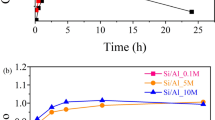Abstract
The effects of prior cold work and solute (or impurity) content on the dissolution rate of Cu in aqueous cupric ammonium carbonate solutions has been studied. Prior cold work increased the dissolution rate, while solute additions of < 0.15 wt pct decreased the rate. Beyond 0.15 wt pct solute the dissolution rate increased with Ag additions, but it decreased further for an alloy of Cu-Cr-Zr. Observations with scanning electron microscopy and X-ray diffraction indicated that a solute build-up that occurs at the surface during dissolution is of primary importance in controlling the dissolution rate.
Similar content being viewed by others
References
K. A. Smith, G. W. Lower, and W. A. Hockings:Proc. Second International Hydrometallurgy Symposium, D.J. I. Evans and R. S. Shoemaker, eds., p. 265,AIME, New York, New York, 1973.
A. L. Titchener and M. B. Bever:Progress in Metal Physics, vol. 7, p. 247, Pergamon Press, New York N.Y.,1958.
L. E. Murr:Electron Optical Applications in Materials Science, p. 109, McGraw-Hill Book Co., New York, N. Y., 1970.
Author information
Authors and Affiliations
Additional information
Formerly Undergraduate Student, Michigan Technological University
Rights and permissions
About this article
Cite this article
Carlson, J.A., Mikkola, D.E. Effect of cold work and alloying additions on the kinetics of dissolution of copper in aqueous cupric ammonium carbonate solutions. Metall Trans 5, 915–919 (1974). https://doi.org/10.1007/BF02643148
Received:
Published:
Issue Date:
DOI: https://doi.org/10.1007/BF02643148




